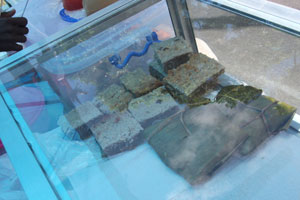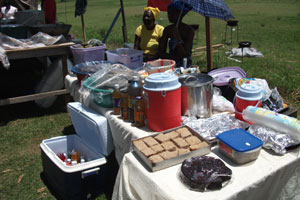OVER the last few weeks, I tried, with little success, to think of a village not much highlighted, but which bears relics of African culture and which could be appropriately highlighted during African Emancipation Month.  It was not until a group of US-based colleagues who hailed from the North West District returned home to conduct a Health Fair and make presentations to the people of the region, a little over a week ago, that I was reminded of Morawhanna.
It was not until a group of US-based colleagues who hailed from the North West District returned home to conduct a Health Fair and make presentations to the people of the region, a little over a week ago, that I was reminded of Morawhanna.
Villages such as Mabaruma, Hosororo, Morawhanna and Kumaka hold special significance and fascination for those visitors, and naturally were placed on their itinerary to visit.
The group, ‘Guyana Aid, Region One’ (GARO), led by its President David Correia, visited Region One during the second week of August, and held a successful week of humanitarian activities. They spent some of the time visiting relatives and friends still living there; fishing in the nearby creeks, and crab hunting at Barima End, about 5 miles from Mabaruma and across the Barima River, where stands the legendary Morawhanna Township.
Morawhanna
Situated on the left bank of the Barima River, in the North West District now known as the Barima-Waini Region One, Morawhanna is one of the first Afro-Guyanese communities to have been settled in that part of the country. Region One is populated primarily by indigenous peoples, but, at least in those days, there had never been ethnic rivalry between the residents. In fact, there had been some amount of inter-ethnic marriages taking place at Morawhanna, with couples living lovingly.
Morawhanna has a rich African cultural history, and important family names to be chronicled in the annals of its history include the Nobles, the Estwick-Gurricks, the Scotlands, the Franks, the Nelsons, the Greenidges, the Belgraves, the Kings and the Gills. Those would have been among the pioneers taking up residence there, probably in the late 1940s.
 |
 |
 |
The township would have been settled earlier than the booming manganese industrial settlement of Matthew’s Ridge, which developed at the turn of the 1950s.
Morawhanna is an official port of entry, and until the advent of air service in the region, was recognized as the gateway to Region One.
Persons entering the District would have had to pass through Morawhanna before reaching settlements such as Matthew’s Ridge and Port Kaituma.
Air service to the region commenced around the early 1970s. Prior to that, passengers and cargo were all transported into and out of the District by Transport and Harbours Department’s (T&HD) steamers – the longest serving of which was the ‘M.V. Lady Northcote’. The vessel sailed out of Port Georgetown on Monday midday, arrived at Morawhanna early on Tuesday, and set out on its return journey to Georgetown by midday on Wednesday. During that time, the Barima River crossing was usually a kaleidoscope of colours, as several smaller boats plied the waterways, taking passengers to and from the huge T&HD vessel, which towered above all else on the river. When the steamer departed, the small village would be almost desolate until the following Tuesday.
And even though, at some time between the 1960s and 1980s, population of the township would have been just about 200, well over 1000 persons from other communities yet passed through the port on Tuesday and Wednesday of each week, mainly on business runs, but others purely for the fun and frolic.
Ironically, the township possessed not one single vehicle, although it had a single roadway of just about one mile long, but villagers were comfortable walking it.
As a former resident of Mabaruma, who had to frequent Morawhanna for several reasons, I can recall only one single obese person (female) in that entire village.
Arriving at Morawhanna at around 06:00 hrs on Tuesday, the steamer would spend the next few hours in the harbour offloading passengers and cargo, before sailing up the Aruka River for its destination – Kumaka, where the bulk of the cargo intended for the district was offloaded.
At around midday on Wednesday, the vessel, laden with cargo — the bulk of which was agricultural produce — would set sail for the capital city.
Village elders
Assuming a lead role in passing on and upholding the culture and mores of the African people in Morawhanna was the Village Mother fondly referred to as ‘Mother Noble’ on the basis of age, experience, and respectability. She shared stories which enlightened the villagers; taught the young people folk songs; and not least, Mother Noble taught villagers about “kweh-kweh”, placing great emphasis on the body movement and significance of the thumping of the feet.
Whenever there was occasion to celebrate things Africa, Mother Noble’s services were hired throughout the District (at Mabaruma as well), where she would perform for various stage shows like only she could.
In just about every home in Morawhanna, there was/were some person/persons possessing specialties that made for a well-rounded approach to Africanism. Best known for culinary specialties was Ms. Bertha Estwick-Gurrick, fondly called ‘Aunt Bertha’, who ran a cook shop that offered a wide range of foods. She was someone who always seemed to be busy in the kitchen.
Ms. Inez Frank was the headmistress of the lone primary school, the SS Peter and Paul Anglican (owned by the Anglican Church); and Nurse Olinda James was similarly the lone health care professional in the township. She continued to serve the lone health centre for about 20 years, the District doctor at Mabaruma making periodic visits from time to time.
One of the known village fathers was Mr. Albert King – celebrated as being a great pianist in his time, who travelled around the district regaling audiences with choice musical pieces. Other elder men taught drumming, sculpting, carving and other art forms.
The Greenidges were among the first entrepreneurs at Morawhanna; they established one of the biggest grocery shops. And more recently, coming out of the Belgrave lineage has been former PPP/C Parliamentarian Mr. Cyril Belgrave. Out of the Nelson clan is popular snack foods and cereals manufacturer Earnest Nelson.
Documentation
Whilst finding official documentation on the history of Morawhanna is presently difficult, my personal experience, as one having spent my childhood days at Mabaruma and visiting Morawhanna with my parents or on school tours, has given me appreciable insights into, and knowledge of, the township.
Previously an active fresh-water port of entry with a population of about 200, Morawhanna boasted an Anglican church, school, police station, a small hospital; a few grocery shops, in which one could get from ‘twine and a fisherman’s hook to an anchor’; and several cook-shops, all neatly lined up in a row.
Morawhanna offered the best in the line of music (from the banjo and guitar to the juke box); fashion; art and craft; and not least, cuisine: steaming hot cook-up rice with chicken, beef tripe and the works; metemgee which couldn’t be metemgee without fluffy duff and moracut (fish); curried chicken; rice dishes with vegetable stews and freshly-caught fried fish with garnished, fried yellow plantains, red wiri-wiri peppers, and parsley.
Strange enough, in those days (the sixties) fried rice never formed part of the menu. It wasn’t known in those parts, and villagers never knew of illnesses such as high cholesterol.
And if snacks were desired for the children, Miss Bertha Estwick-Gurrick had it all: the coldest mauby, ginger beer, red cake, buns, conkie, and cassava pone.
As for fruits, very often those came as complimentary, given away before left to go bad. Those were the Pre-Independence days when Morawhanna had no electric power supply and refrigerators ran on ‘blue flame’ kerosene oil.
Living dangerously
Travel between Georgetown and the North West District was usually dangerous. Scores of male, female and children passengers would fill the ship and aggressively compete with cargo for limited space.
The hatch was always filled to capacity, but passengers were invariably oblivious to the impending dangers they were exposed to on that 24-hour journey, completed as the vessel navigated the raging, murky waters of the Atlantic.
Albeit, there was always gay chatter coming from the women and children, excited at the very thought of being able to visit what country folk in those days matter-of-factly referred to as ‘Town’ (meaning Georgetown).
For the greater part of the journey, male passengers on board slammed dominoes and imbibed alcohol, which they claimed helped ‘settle their stomachs’ and averted sea-sickness.
Frankly, marine travel from Morawhanna to Georgetown was not the best of experiences, but people learnt to endure; and the sailors, into whose hands the vessels were entrusted, did an incredible job under command of Captains like Mr. Skinner and the late Percy Boyce.
Regarded as a kind of tourist attraction within what was then known as the North West District, on average, more than 2,000 people would pass through the port of entry – a few hours’ drive by motor boat from neighbouring Venezuela. It was an occasion to which the country folk looked forward eagerly, and would descend on the location on Mondays and Wednesdays, colourfully dressed, to engage in fun and frolic, trade and commerce.
Current reality
Much has since changed at Morawhanna, and the township is today faced with growing erosion brought on by climate change.
The venerable old folks have passed away, their younger contemporaries have mostly migrated, and life in the township is now a far cry from what had once obtained.
Morawhanna is now best known for its Fish Port Complex, through which fishermen in that part of the region are able to maintain one of the major income generators in that part of the sub-region.



.jpg)










